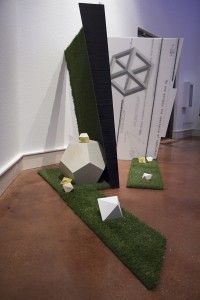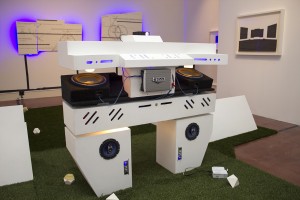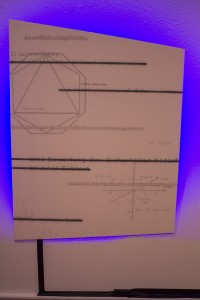By Martin Paredes/south news editor
Ryder Richards’ unique and interactive The Idyll art show is on display in South’s Carillon Gallery until April 2.
The former South instructor has a Master of Fine Arts degree from Texas Christian University and has participated in over 100 exhibits in the last 10 years from places as close as San Antonio and as far away as Switzerland.

Photos by Bogdan Sierra Miranda/The Collegian
The Idyll, which showcases Richards preferential usage of black and white, consists of a space station mixed with the inside of a church surrounded by vertical cubed structures and different geometric shapes all on top of an Astroturf base. The Carillon lights are dimmed, and the purple hue of black lights provides most of the lighting in the gallery.
When first entering, visitors will notice different quotes, equations and ideas written out or blurred out on the cardboard structures of the exhibit — the pyramids as gates to heaven, the Dyson sphere as a means to save mankind from themselves.
“Many are examples of science forming a utopia,” Richards said. “Of course, no one can read all those languages or knows all the math. Some of the text is blacked out, and even if we were smart enough to understand it, some information is still being purposefully kept from us.”
The phrase “no one escapes the spectacle of happiness” is one of the first quotes a visitor will notice walking into the gallery, and it is actually what spurred the title of the exhibit.
“[It] comes from a French surrealist author’s short story titled ‘The Idyll,’ and in the context of the show, it references our purposeful delusions to find and view ‘happiness,’ even if we are miserable doing it,” he said.
The Idyll also expresses how society limits itself.
“We have the tools to be the most intelligent people in history, but [a lot of the time,] it is enough to recognize intelligence rather than understand it,” he said.
The centerpiece of the exhibit is made up of an altar-like structure with a projector, speakers from Richards’ truck and cameras mounted to the front of it. The altar has triangular prisms in front of it where there would typically be benches placed inside of a church.

One of the cameras projects the captured images of visitors onto a wall behind the altar.
“It refocuses the emphasis on the person but gradually fades them out so they lose identity,” he said. “I programmed it to recognize motion, so the actions the individual takes are still visible even when they are not. All of this is meant to question the role of the individual versus the communal desires.”
Richards drew influences for The Idyll from minimalistic art such as the Houston Rothko Chapel where one is supposed to stare and meditate while viewing 14 black canvases.
“This seemed like the pinnacle of worshipping blankness with a promise that it would make you a better person,” he said. “When planning The Idyll, I started to think about how we are caught in a loop of looking at ourselves and our desires instead of actually moving toward a destination.”
Fine arts department chair Joshua Goode expressed his interest in The Idyll even before its completion.
“Rarely have I been as curious about a developing project,” he said. “He has the unique ability to completely transform and control how one encounters a space.”
Goode also credits Richards for making him see the Carillon in a new light.
“I appreciate that Ryder has the ability to completely transform a viewer’s experience of a space,” he said. “Of all of the projects completed in the gallery, this is the first time that I feel as if I am entering a new space, seeing something I’ve seen nearly every day for seven years for the first time.”

South student Jazmyn Garcia found the show to be perplexing to say the least.
“I’m not exactly sure how I feel,” she said. “The whole exhibit was so complex but very interesting.”























